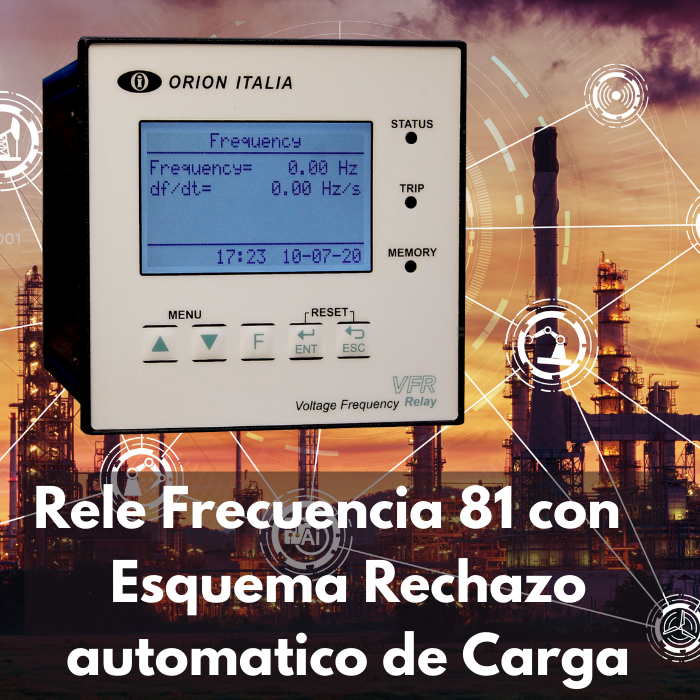Frequency relay 81 - load shedding relay
Automatic Load and Generation Rejection Relay
We have the frequency relay 81, VFR model to provide a solution to the procedure for the automatic rejection of loads that is mandatory in Peru (according to the frequency thresholds indicated by the COES). frequency to send the corresponding signals to the power switches.
customers in the case of rejecting loads due to low frequency or generation in the case of an over frequency. Having an automatic load rejection scheme implemented is necessary to help the system when there are unbalance between energy supply and demand, all in accordance with the thresholds, stages and procedures of the SEIN and COES.
Definition of Load Shedding (Rejection)
In Peru, the acronym RACG has been defined as a protection mechanism against events that occur in the electrical network caused by energy unbalance, which can affect its stability, as a measure of anticipation of major problems, the "Automatic Load Rejection" is carried out. and Generation ”, this is a very important procedure for the interconnected electrical system (SEIN) in order to guarantee the best quality of service in the electrical network.
We consider that the electrical system of Peru (as well as any other country) must be in balance with regard to the instantaneous power (KW) of generation and consumption, that is, the sum of all generation (including interconnections with import flow) must be equal to the consumption of all customers (including interconnections with export flow) in order to have a stable system in voltage (voltage) and frequency parameters, when this is fulfilled, there are unbalance in these variables, which are adjusted by energy management systems in real time, it is a process that is running constantly.
The problem is when these differences between supply and demand are considerable (the load rejection thresholds have been defined by the COES), there more drastic measures must be taken in order to keep the electrical system within a permitted operating range. When the frequency threshold decreases to the values indicated by the COES *, “client” loads must be disconnected to lower consumption and thus return to the desired frequency in the system, on the contrary, when the system frequency increases, it must be disconnect generation, for the automation and detection of these frequency levels a frequency relay of the "protection" range must be used, reliable, robust and with the certainty that it will do its job correctly and quickly in the face of these "movements" up and down. below system frequency,
* COES oficial web: https://www.coes.org.pe/portal/
* Address of the COES: Avenida Los Conquistadores N ° 1144, 2nd floor - San Isidro, Lima - Peru
Minimum Frequency Relay 81 for load rejection
To detect the frequency oscillations and their value in real time, we must have a protection relay for minimum frequency (81m) and maximum frequency (81M) , this in addition to its function of measuring the frequency at all times, will be the equipment where the thresholds or stages of action indicated by the COES are introduced, both for the rejection of load due to low frequency (example: free customers), as well as due to high frequency (example: generators), the disconnection is accentuated more circuits (greater amount of power to be removed from the system) if the unbalance is greater, all timed and with action steps.
Which protection relay to use to comply with load rejection schemes in Peru?
Relays with the following characteristics should be used:
- Electronic protection relay with 81 function.
- df / dt frequency gradient
- Visual display
- Access to configuration via front
- Communication port
- 7 output contacts
* These points correspond to general recommendations on electronic protection relays for use in Low Voltage, Medium Voltage and High Voltage.
What is protection 81?
It is the ANSI 81 Frequency Protection, both for high frequency and low frequency, it can also be called underfrequency and overfrequency, in addition to underfrequency or underfrequency. Protection 81 acts against frequency values above or below the set levels, for the 60 Hz or 50 Hz reference depending on the electrical system of the country where it is being used.
Relay 81 | low and high frequency protection
It is the Frequency Relay 81, according to the ANSI 81 protection relay function. They are currently electronic, with the capacity for low and high frequency detection.
- Low Frequency Protection / Under Frequency Relay / Low Frequency Relay: It is the Protection Relay that acts when the Frequency being measured falls below the specified setting (threshold), for example, if the nominal frequency is 60 Hz and the set this value to 59 Hz, the relay contacts will act when the frequency being monitored decreases from 59 Hz, sometimes it is known as infra-frequency or sub-frequency protection, generally its symbology is ANSI 81L 81m 81U.
- High Frequency Protection / Over Frequency Relay / High Frequency Relay: It is the Protection Relay that acts when the Frequency being measured exceeds the specified setting (threshold), for example, if the nominal frequency is 60 Hz and the set this value to 61 Hz, the relay contacts will act when the frequency being monitored exceeds 61 Hz, generally its symbology is ANSI 81H 81M 81O.
Frequency Relay | Characteristics
The 81 Frequency Relay has the following specifications, features, and functions:
- Display screen of current values and programming settings
- Access to threshold settings and action times
- Access to general configuration (date, time, communications, list of voltage transformers).
- Terminal blocks for inputs, outputs and power supply.
What is electric load rejection?
The rejection of electrical loads is a very useful to protect the electrical system from instabilities between energy consumption and generation, which consists of disconnecting loads when there is not enough generation to support it. The energy required by the loads such as the one that the generation sources can produce must be the same, otherwise there are unbalances, when it is not possible to generate all the energy that is required to consume, frequency drops are produced in the system and through the opening of circuit breakers. power supply, loads are disconnected and the electrical system balanced.
When does load rejection occur?
Load is rejected when the situation of more loads than available generation occurs, there is more demand for energy than can be produced, which unbalances the electrical system and produces a drop in frequency. Loads are rejected to reduce energy consumption so that it is in balance with the available generation and thus return to normal frequency levels in the electrical system
What does underfrequency load rejection mean?
It is a mechanism to protect the national electricity system from unbalances between generation and loads. There is load rejection (disconnection) due to a minimum frequency below 60Hz (according to COES thresholds) to achieve stability between the connected loads and the available generation, in order to improve the system frequency and prevent major problems in the whole. from the power grid.
It also refers to the following definitions:
- Load rejection due to minimum frequency: It is the disconnection of loads when falling below the frequency thresholds set in an 81 minimum frequency relay, in any of its stages or steps. These frequency thresholds are defined in the case of Peru by the COES.
- COES load rejection: These are the schemes for automatic load rejection by frequency (ERACMF) and automatic load rejection by minimum voltage (ERACMT) defined by the Economic Operation Committee (COES).
- OSINERGMIN load rejection: The Energy and Mining Investment Supervisory Body (OSINERGMIN) issues the "Procedure to Supervise the Implementation and Performance of Automatic Load and Generation Rejection Schemes", through its electrical inspection management.
- Rejection between electrical loads: The Rejection between Electrical Loads system is a mechanism designed to protect the electrical system from untimely load variations that affect the frequency of the system and its stability.
- Generation rejection: It is the procedure that affects loads and generation to maintain their balance in the electrical system. This rejection scheme must be implemented to give continuity to the generation by adjusting load disconnection steps, each one with minimum frequency thresholds in the system.
What is a rejection system?
A load and generation rejection system is a protection mechanism for the electrical system against frequency disturbances caused by imbalances between energy consumption and generation. The purpose of this is to maintain the frequency and voltage values in the electrical network within the permitted operating thresholds, for this, when the frequency falls below the permitted values for a set time, the loads are rejected by opening the power switches
What does ERACMF mean?
These acronyms mean Minimum Frequency Load Rejection Automatic Rejection Scheme (ERACMF), for this the following aspects must be defined:
- Maximum level of overload that the scheme will admit
- Maximum load that will be rejected
- Rejection start frequency
- Maximum split frequency drop
Why use the VFR frequency relay for load rejection in Peru?
Our VFR model relay is a sophisticated electronic equipment, based on microprocessor technology, in addition to the functions of high frequency (81M - over frequency) and low frequency (81m - minimum frequency), it is also a device capable of offering the control of 7 levels of load rejection with a schedule that is performed in 5 minutes without requiring specific personnel for programming.
Latin America is one of our markets with the greatest presence, we have more than 20 years of experience as a manufacturer of electronic relays, for all types of sectors: industrial, mining and oil.










